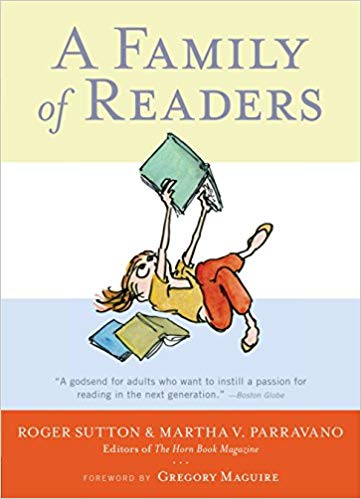Review of A Family of Readers:
The Book Lover's Guide to Children's and Young Adult Literature
by Roger Sutton and Martha V. Parravano
Contents
| Comments | To Buy
Purple
Crayon Bookstores
Book
Reviews Index Page

|
|
Contents of A Family of Readers: Organized by how the editors expect parents will relate to children and their books at different ages--"Reading to Them" (baby books and picture books), "Reading with Them (easy readers and chapter books), "Reading on Their Own" (the many kinds of middle-grade books, and by far the largest section), and "Leaving Them Alone" (books for teens)--each section begins with an introductory overview by one of the editors. Chapters about books of particular kinds follow. An expert, usually someone who specializes in that kind of book, opens each with an overview, and then practitioners ("From the Horn Book Family") --writers, illustrators, and others--write about their experiences. Each chapter closes with a list of recommended, recently published books.
What do the chapters cover? Quite a lot of ground! As you might expect, the first two sections have only two chapters each: Reading to Them has "Books for Babies" and "Picture Books"; Reading with Them has "Easy Readers" and "Chapter Books." Reading on Their Own breaks down into four chapters, and two of these, "Genres" and "Nonfiction" divide further, under such subheads as Fantasy and Historical Fiction or Biography and Poetry (yes, as in the Dewey Decimal System, Poetry gets shelved in Nonfiction). The middle-grade section also includes separate chapters on "Girl Books and Boy Books" and "Messages." The Leaving Them Alone section has only one chapter, "Books for Teens."
"Picture Books" is a typical chapter. Martha Parravano's introduction discusses what is unique about the picture book, and what makes a good one; among other things, she notes that they "work best when they are on the side of the child." The pieces from the H.B. family explore the picture book in more personal terms, or explore particular aspects: for example, Charlotte Zolotow muses about what is different about writing picture books in "The Words" ; Kathleen T. Horning does a sophisticated analysis of how John Steptoe's Baby Says works visually; Jon Scieszka discusses the design of The Stinky Cheese Man and Math Curse with illustrator Lane Smith and designer Molly Leach; and Lolly Robinson answers the question, "What Makes a Good Alphabet Book?"
Comments I have to split my comments in two:
As a parent first, and an editor second, I have to say that I wish I'd had this book when the apple of our eyes was younger. I find the judgments about what is good in children's books almost unerringly correct (in other words, I agree with them), and I even learned about some books I didn't know. Sutton and Parravano have done what they set out to do, and I now have something to give all friends who are expecting babies...
But as an editor first and foremost, this book's publication greatly pleases me. I am always telling writers that they need to know and understand the differences between the genres and age groups and categories in our field; what books of various types are expected to have; and what is being published now, not what they read in their childhoods. A Family of Readers not only includes many lists of recommended books ("More Great Girl Books," for example) in addition to the ones mentioned in the essays, but has a strong point of view about what makes a good book for a particular age, and doesn't hide it. In the essay on Fantasy, for example, Deirdre F. Baker points out that "some contemporary writers of high fantasy seem to think that wordiness, a self-important tone, and an over-dependence on magical creatures, gadgets, and geography . . . can take the place of well-developed, complex characters, ideas, and plot." She then goes on to give examples of books that do not suffer from these failings.
In short, this is a wonderfully opinionated guidebook to the best of children's books, and one that is going to replace The Essential Guide to Children's Books as the one I recommend as a one-volume introduction to what's out there. That book is better for reference, but this is better for someone who wants to know, for example, what is considered the best middle-grade historical fiction..
Who Needs A Family of Readers: Obviously, parents do, but this is also a must-have for writers and illustrators and teachers and librarians and even editors and others working in the children's book field. You won't always agree with the judgments and opinions and recommendations, but they will get you thinking, and the suggested books will get you moving, to the library or the bookstore.
Where and How to Purchase A Family of Readers:
- Buy A Family of Readers at Amazon.
- Buy A Family of Readers through Bookshop, an online bookstore that supports independent bookstores.
- Buy A Family of Readers at Amazon Canada, if you live in Canada.
- Buy A Family of Readers at Amazon UK, if you live in the UK: the guidance in this crosses the Atlantic well.
You can, of course, also purchase this at any bookstore. If they don't have it in stock, they can order it for you.
Disclosure: I received a review copy of this book free of charge from the publisher, as do most reviewers. I also earn commissions on purchases of books via links on this site, as explained on my policy page.
This review is copyright © by Harold Underdown ( Google + Profile ). If you wish to reproduce it, please see the Terms of use. Last modified 3/23/2021.